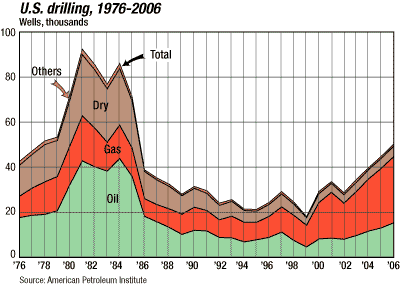OUTLOOK 2007: US DRILLING
US leads the world in drilling
The good times are continuing, but there are signs that the drilling curve may be creaming. Growth in US drilling activity should continue in 2007, increasing nearly 7%. While this growth is slower than the immediate past, it nevertheless would be the fifth consecutive year of increase. The 2007 story centers on continued faith in gas and oil prices, with the majors’ focus on development activity.
When compared with other regions around the globe, the US is a bright spot for 2007, considering that drilling outside the US is expected to decrease by 4.7%. Moreover, the US drilled nearly as many wells as the rest of the world combined.
One year ago, World Oil forecast that in 2006, the US would drill 45,604 wells. By midyear, noting that operators were delirious over $75/bbl oil and able to somehow access rigs, we revised the full-year figure to 49,177. The final 2006 numbers came in very close, estimated at 48,929 wells.
World Oil’s forecast for 2007 shows:
• US drilling activity will continue to increase, albeit at a more modest pace, to 52,208 wells.
• Despite recent intraday oil prices briefly dipping into the psychologically harrowing sub-$50/bbl level, forecasters predict a healthy $60/bbl WTI benchmark for 2007, with gas unchanged in the $7–$8/Mcf (Henry Hub) range.
• The US rig count will average 1,767 rigs, up 6.9%.
US prices. Pickering Energy Partners, an equity research firm, forecasts that oil prices will average $60/bbl for West Texas Intermediate in 2007, down slightly from the $66/bbl average for 2006 (which exceeded the $57/bbl we had forecast). As this forecast was going to press, however, oil prices had taken a plummet—skidding below the $50/bbl mark in intraday trading. While perhaps causing some concern for operators, this sub-$50/bbl pricing is not reflected in their plans, which are more likely based on a broader consensus of higher prices.
Even though winter feels as though it is just getting started in the northern hemisphere, oil-price forecasters are already looking ahead to the driving season and are closely watching gasoline inventory levels—and refinery efficiency during turnaround season—as a bellwether for 2007 oil pricing.
After a yearlong roller coaster ride, gas prices ended 2006 with an average level of $7/Mcf (NYMEX)—the same as Pickering forecasts for 2007. Last year, it was the hope that more hurricanes would keep oil and gas prices high. This year, for gas—which is over 80% of all US drilling—it’s the hope of months of sustained cold weather to reduce high storage levels. The fact that the first hope never materialized, and the second hope now seems unlikely, has not had much of an effect on prices.
Forecast of 2007 US wells and footage to be drilled
Click image for enlarged view
|
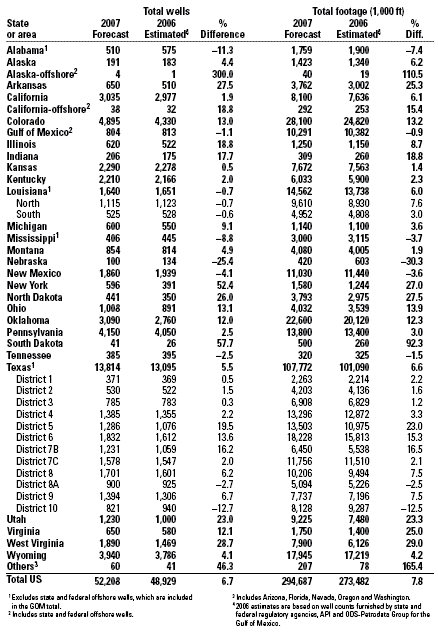 |
|
Since the US is largely a natural gas story, the softening of gas prices in the fourth quarter of 2006—the planning season for many capital budgets—spooked enough operators that we see considerable disparity in regional US drilling activity planned for 2007. Demand will be the big story in setting oil and gas prices in 2007, as there now exists adequate-to-ample supply.
US operators survey. World Oil’s year-end survey of 16 US major drillers (integrated companies and independents with large drilling programs) and 160 independents had the strongest response rate in recent memory.
The forecast for independents versus the majors highlights some interesting trends. The majors appear to be playing it much safer in 2007, with a paltry 2.8% of total drilling activity to be exploratory, drilling the same number of wildcats as they did in 2006. Majors’ development drilling activity, however, is expected to have a robust 15% jump in wells for the coming year. Majors are continuing their modest retreat from the Gulf of Mexico (GOM), following the rigs to other waters. The independents plan a 20% increase in activity with a steady 13% of efforts targeted to exploratory drilling.
In our survey, independents and majors plan a combined total of 20,543 wells for 2007, about 40% of all US wells drilled. While the US overall should experience an increase in drilling activity, the survey data was very uneven, with some operators pulling completely out of an area, while others piled in.
US rigs. Offshore, rigs appear to be slowly exiting the Gulf of Mexico, though not in a mass exodus, for greener waters offshore areas like India, the Middle East and Southeast Asia. This has been an ongoing trend for several years, with influx and outgoing rig counts. But the general trend is gradually downward. On land, there appears to be less growth in coalbed methane drilling, but the overall level is still quite high.
What 16 US independents1 plan for 2007
Click image for enlarged view |
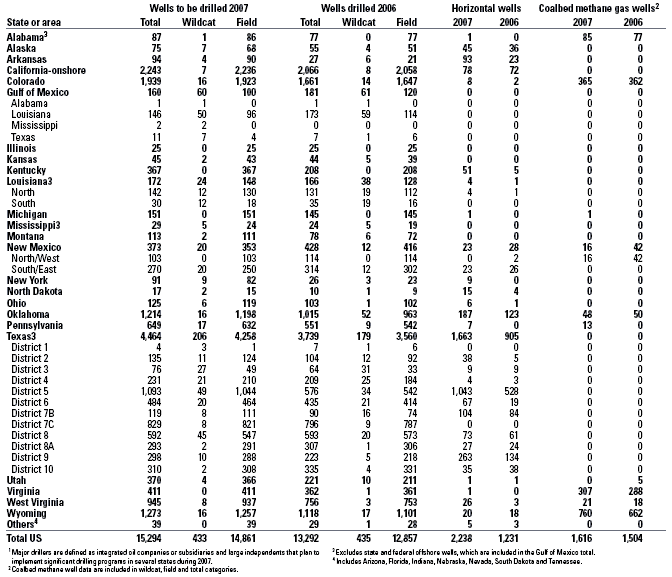 |
|
The run-up in rigs was so steep last year—a 19.4% year-to-year average—that the modest 6.9% increase expected this year will likely be achieved within the first two months of 2007. This would imply a flattening of the drilling rig curve, but at a very high level.
Area highlights. Nebraska, while only a 34-well drop, will have the largest percentage reduction (–25%) in drilling activity. On the other end of the scale, Arkansas, Colorado and New York will have healthy double-digit jumps in drilling. In absolute terms, Texas, Colorado, Pennsylvania and Wyoming will again take top honors as the busiest states for US drilling activity. Oklahoma is eking past California as the sixth most active state in 2007.
Ongoing trends include continuous-resource plays—formations that run for 50 to 100 or more miles throughout the country. Horizontal wells, mostly oil, are being drilled in the Bakken in Williston basin on both the Montana side, which is calling for a modest 5% increase in drilling, and spreading into North Dakota. This continuous resource play is under reassessment by governmental and private firms, and will likely be touted as a many-billion bbl resource. But it will take the very best horizontal drilling and stimulation technology to get it out—and a steep learning curve as to how to do it cheaply.
While coalbed methane shows some signs of leveling off, shale gas drilling is climbing steadily. First tested in late 2004, the Barnett Shale near Dallas, Texas, which straddles the Arkoma basin, is well into its learning curve. Fracing and drilling technologies are fine-tuning the development, as operators are still expanding the limits of this play.
Arkansas’ Fayetteville Shale is beginning to look like another Barnett Shale. There, operators have quietly, and not-so quietly, snatched up some 2 million acres of leases. The play should have at least 20 rigs operating during 2007.
Colorado regulators anticipate that nearly half of all wells in that state will be directionally drilled in 2007, as operators pursue the Williams Fork play in the Piceance basin and other plays in the DJ basin. In addition, advances in rig technology allow the drilling of as many as 22 wells from a single pad, and at spacings as little as 10 acres. Increased activity will center on the DJ basin’s Codell/Niobrara play, as well as CBM activity in the Williams Fork play in the Piceance basin. Relatively strong gas prices have also caused a spike in permitting requests for a shallow play in Yuma County. All of this is contributing to the anticipated 13% growth in drilling activity for the state, with 4,895 wells planned.
What 160 US independents1 plan for 2007
Click image for enlarged view |
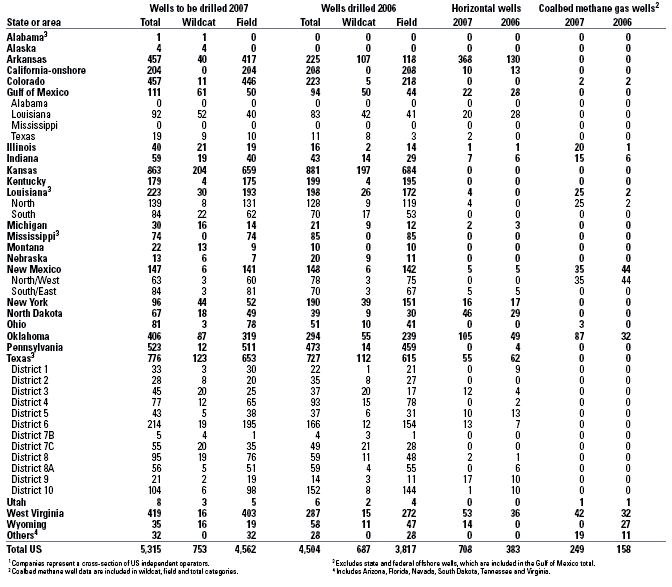 |
|
Active Gulf of Mexico operators and wells drilled in 2006
Click image for enlarged view |
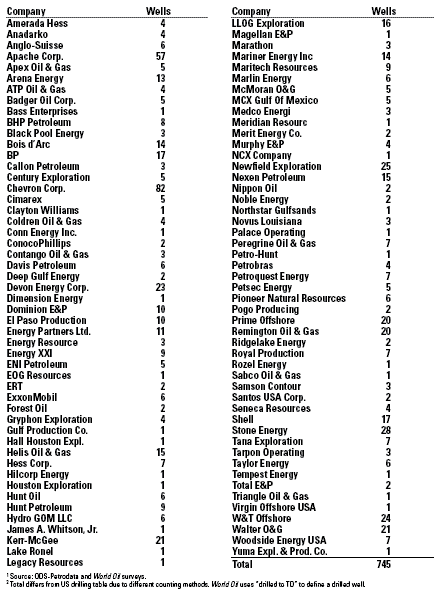 |
|
West Virginia’s CBM play is also benefiting from sustained gas prices—from an historical basis—with a 29% jump in drilling activity.
New York. Proportionally speaking, New York should see one of the biggest jumps in statewide drilling activity in 2007, with a planned increase of more than 200 wells over the 2006 estimated total of 391 wells. First tapped in 1999, the Trenton/Black River play near the Finger Lakes region of New York is part of the reason for the increase, with a 27% boost in wells planned.
Texas. In and of itself, Texas is a microcosm of the US, with some regions growing strongly and others retreating. Steady drilling activity in East Texas Districts 5 and 6 and the Barnett Shale play in District 7B, should drive a 14-to-25% growth over 2006 levels. These gas plays contrast with the decline in planned activity in the Panhandle’s District 10, which should see a nearly 13% drop in drilling activity.
About these statistics. World Oil’s tables are produced using the aid of data from a variety of sources, including the American Petroleum Institute, ODS-Petrodata Group, Pickering Energy Partners, the Texas Railroad Commission, other state and federal regulatory agencies, and international regulatory agencies. In addition, operating companies with drilling programs responded to this year’s surveys. Please note credits and explanations in table footnotes. We thank all contributors for their time and effort in providing data and analysis to this report.
World Oil editors try to be as objective as possible in this estimating process to present what they believe is the most current data available. It is realized that sound forecasting can only be as reliable as the base data. In this respect, it should be noted that well counting is a dynamic process and most historical data will be continually updated over a period of several years before the “books are closed” on any given year. 
|




